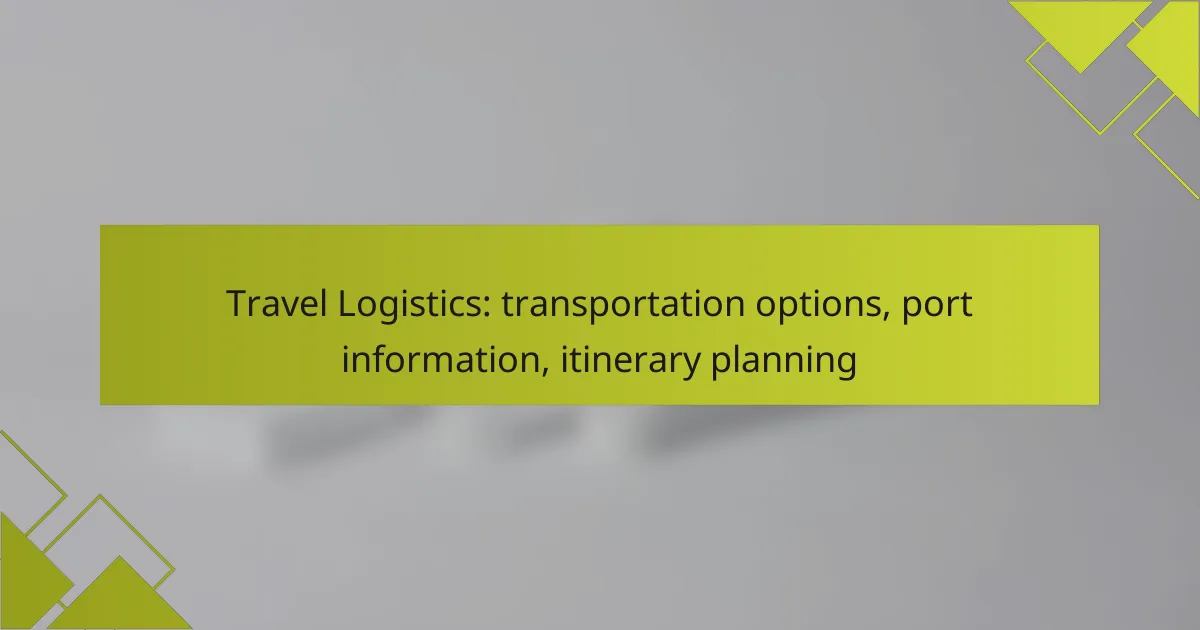Effective travel logistics are crucial for a seamless journey, encompassing various transportation options tailored to your destination and budget. Whether you prefer air travel, trains, buses, or car rentals, understanding each mode’s benefits can enhance your experience. Additionally, for cruise travelers, accessing accurate port information is vital for smooth embarkation. Thoughtful itinerary planning, including defining dates and researching accommodations, ensures that every aspect of your trip is well-organized and enjoyable.

What are the best transportation options for travel logistics?
The best transportation options for travel logistics vary based on destination, budget, and personal preferences. Air travel, train services, bus networks, car rentals, and ride-sharing services each offer distinct advantages for different types of trips.
Air travel with major airlines
Air travel is often the fastest way to cover long distances, especially for international trips. Major airlines like Delta, American Airlines, and Lufthansa provide extensive networks, allowing travelers to reach various destinations efficiently.
When booking flights, consider factors such as layover times, baggage policies, and ticket prices. Using comparison websites can help identify the best deals, which often range from budget-friendly options to premium services.
Train services in Europe
Train services in Europe are renowned for their efficiency and convenience, making them an excellent choice for intercity travel. High-speed trains like the Eurostar and TGV connect major cities, allowing for quick and comfortable journeys.
Travelers should consider purchasing a Eurail Pass for unlimited travel across multiple countries, which can be cost-effective for those planning extensive itineraries. Always check the train schedules in advance, as they can vary significantly between regions.
Bus networks in North America
Bus networks in North America, such as Greyhound and Megabus, provide affordable travel options for budget-conscious travelers. These services connect cities and towns, often with multiple daily departures.
While bus travel can take longer than flying or taking a train, it is generally more economical. Booking tickets in advance can yield significant savings, and travelers should be aware of amenities like Wi-Fi and onboard refreshments.
Car rentals from companies like Hertz
Car rentals offer flexibility and convenience, especially for exploring rural areas or regions with limited public transport. Companies like Hertz, Enterprise, and Avis provide a range of vehicles to suit different needs and budgets.
When renting a car, consider insurance options, fuel policies, and mileage limits. It’s advisable to book in advance to secure better rates, which can vary widely based on location and season.
Ride-sharing services like Uber
Ride-sharing services like Uber and Lyft are popular for short trips within cities, providing a convenient alternative to traditional taxis. These platforms allow users to request rides via mobile apps, often with upfront pricing.
When using ride-sharing, check for surge pricing during peak hours, which can increase costs significantly. It’s also wise to verify driver ratings and vehicle details for safety and reliability.

How to find port information for cruises?
To find port information for cruises, start by visiting official cruise line websites or port authority pages. These resources provide essential details such as location, facilities, and transportation options, ensuring a smooth embarkation process.
Port details for Miami Cruise Port
Miami Cruise Port, one of the busiest in the world, features several terminals catering to major cruise lines. Each terminal offers amenities like parking, dining, and shopping, making it convenient for travelers.
When planning your trip, consider the port’s proximity to Miami International Airport, which is about 15 minutes away by taxi. It’s advisable to arrive at least a few hours before your cruise departure to account for check-in and security procedures.
Information on Port of Los Angeles
The Port of Los Angeles serves as a key gateway for cruises along the West Coast. It offers multiple terminals, each equipped with facilities for passengers, including waiting areas and transportation services.
Travelers should be aware that traffic can be heavy in the area, especially during peak hours. Arriving early is recommended, and options for parking or shuttle services are available for those driving to the port.
Resources for Port of Southampton
Port of Southampton is a major departure point for cruises to various destinations, particularly in Europe and the Caribbean. The port features modern terminals with amenities such as shops and cafes.
For those flying in, Southampton Airport is nearby, and there are various transport options, including trains and taxis. It’s wise to check the port’s official website for real-time updates on schedules and services to ensure a seamless experience.

What are the key steps in itinerary planning?
Itinerary planning involves several essential steps to ensure a smooth travel experience. Key actions include defining travel dates and destinations, researching accommodations and activities, and utilizing planning tools to organize all details effectively.
Define travel dates and destinations
Start by selecting your travel dates and destinations, as these are the foundation of your itinerary. Consider factors like weather, local events, and peak tourist seasons, which can affect both availability and pricing.
For instance, traveling to Europe in the summer may offer pleasant weather but also higher prices and crowds. Conversely, visiting during the shoulder seasons can provide a more relaxed experience at lower costs.
Research accommodations and activities
Once your dates and destinations are set, research suitable accommodations and activities. Look for hotels, hostels, or vacation rentals that fit your budget and preferences, and consider their proximity to attractions.
For activities, check local tourism websites or platforms like TripAdvisor for recommendations. Prioritize experiences that align with your interests, whether they are cultural, adventurous, or culinary.
Utilize itinerary planning tools like TripIt
Using itinerary planning tools can streamline your travel organization. Applications like TripIt allow you to consolidate all your travel information, including flight details, accommodation bookings, and activity reservations, in one place.
These tools often provide real-time updates and alerts, helping you stay informed about any changes. Additionally, they can generate a shareable itinerary for family or friends traveling with you, enhancing collaboration and communication.

What criteria should I consider when choosing transportation?
When choosing transportation, consider factors such as cost, travel time, convenience, and accessibility. Evaluating these criteria will help you select the best option for your travel needs.
Cost-effectiveness of options
Cost is a primary factor in transportation choices. Compare different modes, such as buses, trains, and flights, to determine which offers the best value for your budget. For example, bus fares may range from low single digits to low tens of USD, while flights can vary significantly based on distance and timing.
Look for discounts, especially for early bookings or group travel. Some services offer loyalty programs that can further reduce costs over time. Always factor in additional fees, such as baggage charges or seat selection, when calculating total expenses.
Travel time and convenience
Travel time can greatly affect your overall itinerary. Assess the duration of each transportation option, including waiting times and transfers. For instance, a direct flight may take a couple of hours, while a train journey with multiple stops could extend to several hours or more.
Convenience also plays a role; consider the proximity of transport hubs to your accommodation and the availability of services like luggage assistance. Opt for options that minimize transfers and delays to enhance your travel experience.
Accessibility for individuals with disabilities
Accessibility is crucial for travelers with disabilities. Check if transportation providers comply with local regulations, such as the Americans with Disabilities Act (ADA) in the United States, which mandates accessible services. Many airlines and train companies offer assistance, but it’s essential to request this in advance.
Evaluate the accessibility features of each option, such as wheelchair ramps, designated seating, and assistance for boarding. Websites often provide detailed information on accessibility, helping you make informed choices that meet specific needs.

How can I optimize my travel itinerary?
To optimize your travel itinerary, focus on efficient planning that maximizes your time and enjoyment. Consider using technology, local events, and a balanced approach to activities to create a seamless travel experience.
Use travel apps for real-time updates
Travel apps can significantly enhance your itinerary by providing real-time updates on transportation, weather, and local attractions. Popular apps like Google Maps, TripIt, and local transit apps can help you navigate changes and delays effectively.
Make sure to enable notifications for these apps to receive alerts about any disruptions or changes in your plans. This proactive approach can save you time and reduce stress during your trip.
Incorporate local events into plans
Integrating local events into your travel itinerary can enrich your experience and provide unique insights into the culture. Research festivals, concerts, or markets happening during your visit to find opportunities that align with your interests.
Check local tourism websites or social media pages for event schedules. Attending these events can also help you connect with locals and other travelers, making your trip more memorable.
Balance leisure and sightseeing activities
Striking a balance between leisure and sightseeing is crucial for a fulfilling travel experience. Plan your itinerary to include both structured activities and downtime to relax and recharge.
A good rule of thumb is to allocate about 60% of your time to sightseeing and 40% to leisure. This approach allows you to explore attractions while still enjoying the local ambiance, whether it’s lounging at a café or strolling through a park.

What are the emerging trends in travel logistics?
Emerging trends in travel logistics focus on enhancing efficiency, sustainability, and technology integration. Innovations such as real-time data analytics, electric vehicles, and seamless connectivity are reshaping how travelers plan and experience their journeys.
Sustainable transportation options
Sustainable transportation options are gaining traction as travelers increasingly prioritize eco-friendly choices. These options include electric vehicles, public transportation, cycling, and walking, all of which reduce carbon footprints and promote healthier lifestyles.
When considering sustainable transport, look for services that utilize renewable energy sources or offer carbon offset programs. For example, many cities now provide electric bike rentals or electric public transit options that are both convenient and environmentally friendly.
Travelers should also consider the trade-offs between convenience and sustainability. While public transport may take longer than driving, it often provides a more immersive experience of the local culture and can be significantly cheaper, especially in urban areas where parking fees can add up.



